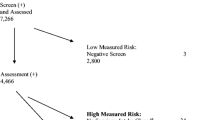Abstract
Confirmed child abuse and neglect rates were assessed for a group of 204 low-income, low-education adolescent mothers several years after identification of the teens either as low-risk or as high risk/low-support and eligible for 18 to 27 months of home-visitation by trained child development specialists. Three groups were studied: Low-risk Contrast Group, High-risk Program Graduates, and a Dropout Comparison Group—the last group being formed unintentionally when some participants dropped out of the high risk program. The major finding of this study is that acceptance of high-risk mothers into program prior to the infant's birth made a significant difference in preventing later child abuse/neglect. Child abuse/neglect rates and subsequent parity rates were not different between high-risk program graduates and low-risk contrast group members. Both of these groups differed significantly on these two rates with the Dropout Comparison Group. However, due to the unknown nature of this comparison group, more research is needed to understand this finding. Program costs were significantly lower than county foster care costs for children placed because of child abuse. Thus, prenatal initiation of program for high-risk pregnant adolescents may provide a cost-effective boost for family mental health and prevent child abuse and neglect by at-risk families.
Similar content being viewed by others
References
Basic Behavioral Science Task Force of the National Advisory Mental Health Council. (1996). Basic behavioral science research for mental health: Family processes and social networks. American Psychologist, 51 (6), 622-630.
Erikson, E. (1963). Childhood and society. New York: Norton.
Fraiberg, L. (Ed.) (1984). Clinical studies in infant mental health. Columbus, OH: Ohio University Press.
Grayson, J. (Ed.) (1996, Summer). Treatment outcome Part 111: Intervention for the child. Virginia Child Protection Newsletter, 48, 1 –3, 11-13.
Honig, A. S. (1979). Parent involvement in early childhood education. Washington, D.C.: National Association for the Education of Young Children.
Honig, A. S. (1993). Mental health for babies: What do theory and research tell us? Young Children, 48 (3), 69-76.
Kaplan, L. (1978). Oneness and separateness. New York: Simon and Schuster.
Klass, C. S. (1996). Home visiting: Promoting healthy parent and child development. Baltimore, MD: Paul H. Brookes.
Lally, J. R., Mangione, P. L., & Honig, A. S. (1988). The Syracuse University Family Development Research Program: Long-range impact of an early intervention with low income children and their families. In D. Powell (Ed.), Parent education as early childhood intervention: Emerging directions in theory, research, and practice (pp.79-104). Norwood, NJ: Ablex Publishers.
Olds, D. L. (1986). Case studies of factors interfering with nurse home visitors'promotion of positive caregiving methods in high risk families. In A. S. Honig (Ed.) Risk factors in infancy (pp. 149-165). London: Gordon & Breach Science Publishers.
Ramey, C. T., & Ramey, S. L. (1996). Home visiting programs and the health development of young children. In K. L. Frieberg (Ed.) Annual editions (pp. 69-78). Guilford, CT: Dushkin/McGraw Hill Publishing.
U.S. General Accounting Office (1990). Home visiting: A promising early intervention strategy for at-risk families. Report No. B-238394. Gaithersburg, MD: U.S. General Accounting Office.
Author information
Authors and Affiliations
Rights and permissions
About this article
Cite this article
Honig, A.S., Morin, C. When Should Programs for Teen Parents and Babies Begin? Longitudinal Evaluation of a Teen Parents and Babies Program. The Journal of Primary Prevention 21, 447–454 (2001). https://doi.org/10.1023/A:1007106811238
Issue Date:
DOI: https://doi.org/10.1023/A:1007106811238



